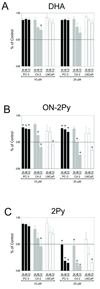Effect of artemisinin derivatives on apoptosis and cell cycle in prostate cancer cells
- PMID: 20130467
- PMCID: PMC2953769
- DOI: 10.1097/CAD.0b013e328336f57b
Effect of artemisinin derivatives on apoptosis and cell cycle in prostate cancer cells
Abstract
Artemisinin is a plant-derived anti-malarial drug that has relatively low toxicity in humans and is activated by heme and/or intracellular iron leading to intracellular free radical formation. Interestingly, artemisinin has displayed anti-cancer activity, with artemisinin dimers being more potent than monomeric artemisinin. Intracellular iron uptake is regulated by the transferrin receptor (TfR), and the activity of artemisinin depends on the availability of iron. We examined the level of TfR in prostate cancer (PCa) tumor cells, synthesized two new artemisinin dimers, and evaluated the effect of dihydroartemisinin and artemisinin dimers, ON-2Py and 2Py, on proliferation and apoptosis in PCa cells. TfR was expressed in the majority of PCa bone and soft tissue metastases, all 24 LuCaP PCa xenografts, and PCa cell lines. After treatment with dihydroartemisinin, ON-2Py, or 2Py all PCa cell lines displayed dose-dependent decrease in cell number. 2Py was most effective in decreasing cell number. An increase in apoptotic events and growth arrest was observed in the C4-2 and LNCaP cell lines. Growth arrest was observed in PC-3 cells, but no significant change was observed in DU 145 cells. Treatment with 2Py resulted in a loss of the anti-apoptotic protein survivin in all four cell lines. 2Py treatment also decreased androgen receptor and prostate-specific antigen expression in C4-2 and LNCaP cells, with a concomitant loss of cell cycle regulatory proteins cyclin D1 and c-Myc. This study shows the potential use of artemisinin derivatives as therapeutic candidates for PCa and warrants the initiation of preclinical studies.
Figures






Similar articles
-
Transferrin receptor-dependent cytotoxicity of artemisinin-transferrin conjugates on prostate cancer cells and induction of apoptosis.Cancer Lett. 2009 Feb 18;274(2):290-8. doi: 10.1016/j.canlet.2008.09.023. Epub 2008 Nov 8. Cancer Lett. 2009. PMID: 19006645
-
Effects of transferrin conjugates of artemisinin and artemisinin dimer on breast cancer cell lines.Anticancer Res. 2013 Jan;33(1):123-32. Anticancer Res. 2013. PMID: 23267137
-
SRJ23, a new semisynthetic andrographolide derivative: in vitro growth inhibition and mechanisms of cell cycle arrest and apoptosis in prostate cancer cells.Cell Biol Toxicol. 2014 Oct;30(5):269-88. doi: 10.1007/s10565-014-9282-5. Epub 2014 Jul 29. Cell Biol Toxicol. 2014. PMID: 25070834
-
Artemisinin and its derivatives: a promising cancer therapy.Mol Biol Rep. 2020 Aug;47(8):6321-6336. doi: 10.1007/s11033-020-05669-z. Epub 2020 Jul 24. Mol Biol Rep. 2020. PMID: 32710388 Review.
-
Development of artemisinin compounds for cancer treatment.Invest New Drugs. 2013 Feb;31(1):230-46. doi: 10.1007/s10637-012-9873-z. Epub 2012 Aug 31. Invest New Drugs. 2013. PMID: 22935909 Review.
Cited by
-
Structurally diverse c-Myc inhibitors share a common mechanism of action involving ATP depletion.Oncotarget. 2015 Jun 30;6(18):15857-70. doi: 10.18632/oncotarget.4327. Oncotarget. 2015. PMID: 26036281 Free PMC article.
-
Antitumor activity of artemisinin and its derivatives: from a well-known antimalarial agent to a potential anticancer drug.J Biomed Biotechnol. 2012;2012:247597. doi: 10.1155/2012/247597. Epub 2011 Nov 22. J Biomed Biotechnol. 2012. PMID: 22174561 Free PMC article. Review.
-
Artemether suppresses cell proliferation and induces apoptosis in diffuse large B cell lymphoma cells.Exp Ther Med. 2017 Nov;14(5):4083-4090. doi: 10.3892/etm.2017.5063. Epub 2017 Aug 29. Exp Ther Med. 2017. PMID: 29104626 Free PMC article.
-
Organotypic culture of breast tumor explants as a multicellular system for the screening of natural compounds with antineoplastic potential.Biomed Res Int. 2015;2015:618021. doi: 10.1155/2015/618021. Epub 2015 May 17. Biomed Res Int. 2015. PMID: 26075250 Free PMC article.
-
In vitro cardiovascular effects of dihydroartemisin-piperaquine combination compared with other antimalarials.Antimicrob Agents Chemother. 2012 Jun;56(6):3261-70. doi: 10.1128/AAC.05688-11. Epub 2012 Mar 5. Antimicrob Agents Chemother. 2012. PMID: 22391528 Free PMC article.
References
-
- Efferth T, Dunstan H, Sauerbrey A, Miyachi H, Chitambar CR. The anti-malarial artesunate is also active against cancer. Int J Oncol. 2001;18:767–773. - PubMed
-
- Nakase I, Gallis B, Takatani-Nakase T, Oh S, Lacoste E, Singh NP, et al. Transferrin receptor-dependent cytotoxicity of artemisinin-transferrin conjugates on prostate cancer cells and induction of apoptosis. Cancer Lett. 2009;274:290–298. - PubMed
-
- Posner GH, McRiner AJ, Paik IH, Sur S, Borstnik K, Xie S, et al. Anticancer and antimalarial efficacy and safety of artemisinin-derived trioxane dimers in rodents. J Med Chem. 2004;47:1299–1301. - PubMed
-
- Nakase I, Lai H, Singh NP, Sasaki T. Anticancer properties of artemisinin derivatives and their targeted delivery by transferrin conjugation. Int J Pharm. 2008;354:28–33. - PubMed
-
- Duffy PE, Mutabingwa TK. Drug combinations for malaria: time to ACT? Lancet. 2004;363:3–4. - PubMed
Publication types
MeSH terms
Substances
Grants and funding
LinkOut - more resources
Full Text Sources
Other Literature Sources
Medical
Research Materials
Miscellaneous

